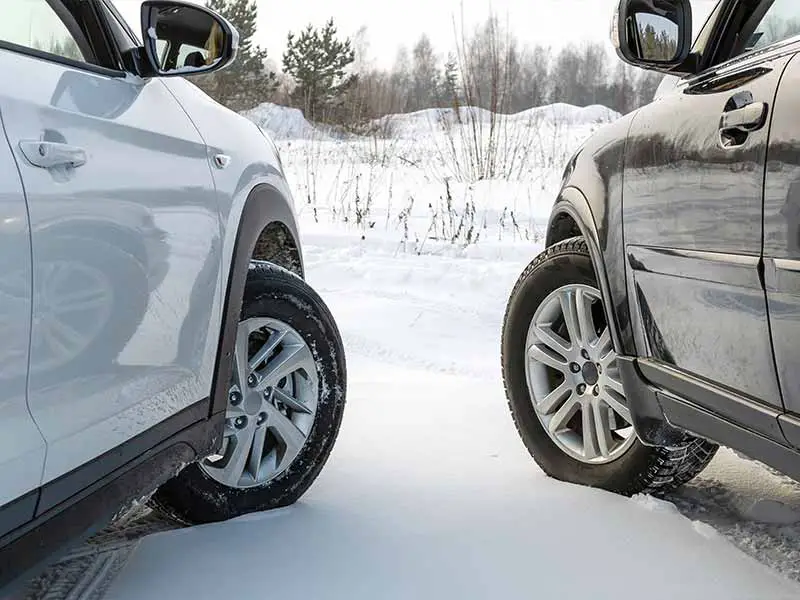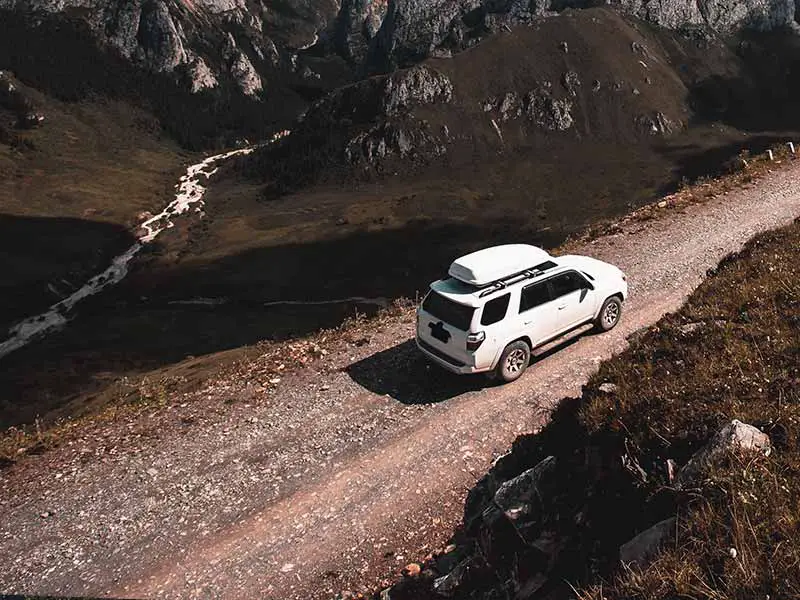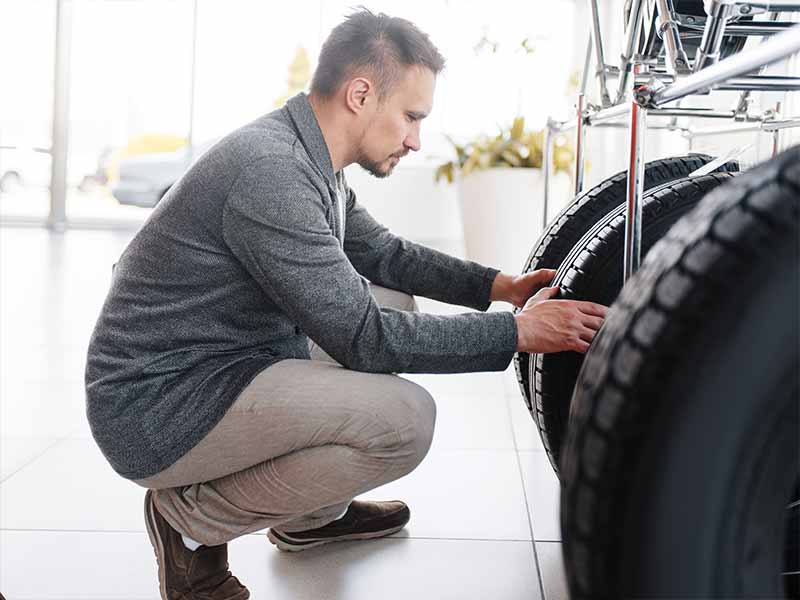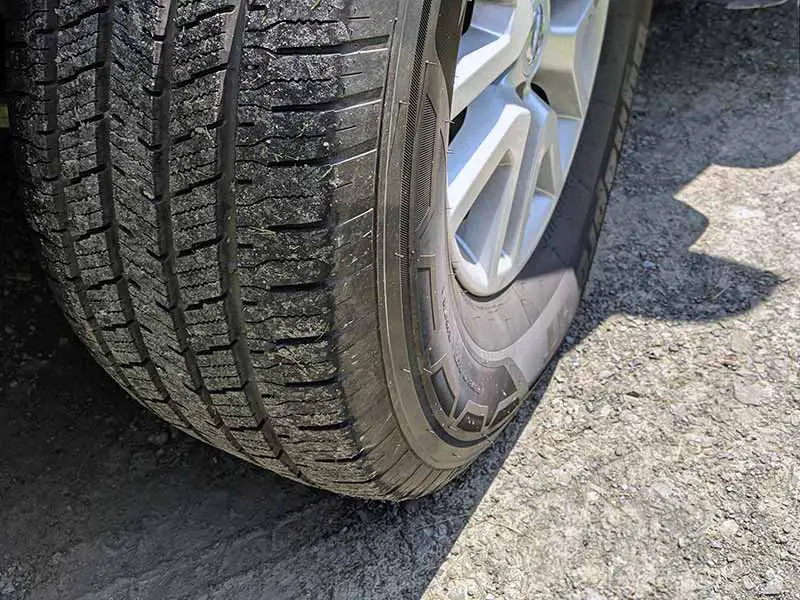Ever wondered what “HT” means when talking about tires? Especially when you’re trying to pick the best tire for your truck, knowing about HT tires is key to making sure your rides are smooth and safe on all kinds of roads.
What Does HT Mean On A Tire?
HT means Highway Terrain on a tire. These tires are great for regular roads because they give a smooth, quiet ride and usually last a long time. They’re perfect for vehicles that are mostly driven on highways and city streets but might not be the best for off-road driving or carrying heavy loads.
In this article, we’re going to talk all about HT tires – what they’re made of, the good stuff, and the not-so-good stuff, and how they compare to other tires like LT, AT, and MT. This guide is here to help you know everything you need to pick the right tires, making sure they work well, last long, and keep you safe.
Let’s take a closer look.

What Are HT Tires?
HT tires, which stands for Highway Terrain tires, are a common type of tire that you’ll often find on trucks. But, they’re not just for trucks! You can also find them on some regular cars and family vehicles, like SUVs and minivans.
Highway tires are designed for driving on regular roads, like city streets and highways, because they provide a smooth and quiet ride. So, whether you’re driving a big truck or just taking the family car out for a spin around town, HT tires are a popular choice for many different kinds of vehicles that spend most of their time on well-paved roads.
Key Features of HT Tires
- Smooth Tread Pattern: HT tires have a smooth pattern on them, which helps give a quiet and comfy ride. The pattern isn’t as rough or aggressive as you’d find on All-Terrain (AT) or Mud-Terrain (MT) tires.
- Long-Lasting: These tires are known for lasting a long time. The rubber and design are made to handle lots of miles on the highway without wearing out fast.
- Good on Gas: HT tires can help save gas because they give a smooth ride and don’t make the engine work too hard.
- Good in the Rain: They usually have little slits (called siping) that help give grip in the rain, making them safe for wet weather driving.
When to Use HT Tires
HT tires are a good choice for:
- Everyday Driving: Regular drives like going to work, school, or running errands where the roads are mostly paved and in good shape.
- Long Road Trips: Trips that need a lot of highway driving, where a smooth and quiet ride is nice to have.
- Carrying Light Loads: They can handle some weight but aren’t made for super heavy stuff. They’re good for normal loads like groceries, suitcases, or everyday items.
Limits of HT Tires
Even though HT tires are great in many situations, it’s important to know what they can’t do well:
- Off-Roading: HT tires aren’t made for off-road use. Their smooth pattern isn’t made for dealing with mud, rocks, or bumpy terrains.
- Carrying Heavy Loads: If you’re always hauling heavy stuff or pulling big trailers, Light Truck (LT) tires might be a better choice because they’re made stronger.

Pros and Cons of HT Tires
Pros of HT Tires
Smooth and Quiet Rides
- Steady Driving: HT tires give a steady and stable ride because they have a smooth pattern on them.
- Less Road Noise: They don’t make a lot of noise on the road, so your drive is quieter, especially on highways.
Saves Gas
- Easy Rolling: The smooth pattern makes the tire roll easily, which can help save gas.
- Less Work for the Car: The car doesn’t have to work as hard to move, which can save you money on gas over time.
Lasts a Long Time and Tough
- Long-Lasting: HT tires are known for lasting a long time, which means you don’t have to buy new ones as often.
- Wears Out Evenly: They usually wear out evenly if you take care of them, so they keep working well for a long time.
Good in the Rain
- Handles Wet Roads: The little slits in the tires (called sipes) help to grip wet roads, making them safe for driving in the rain.
Cons of HT Tires
Not Great Off-Road
- Smooth Pattern: The smooth pattern isn’t great for off-road driving because it doesn’t grip rough surfaces well.
- Less Traction: They don’t have the kind of grip you need for safe and fun off-road driving.
Not for Heavy Stuff
- Not Super Strong: While they’re tough, HT tires might not be strong enough to handle really heavy loads or towing all the time.
- Can Wear Out Faster: If you use them for heavy hauling a lot, they can wear out faster and might not be as safe.
Not the Best in Extreme Weather
- Snow and Ice: HT tires might not grip as well in snow or ice compared to special winter tires.
- Really Hot Weather: In super hot weather, if you drive on really hot roads a lot, HT tires might not last as long.

Using HT Tires in Different Weather and Situations
Driving in Snow
- Slippery: HT tires might not grip snowy roads very well because they have a smooth pattern.
- Winter Tires: If it snows a lot where you live, you might want to use winter tires that are made for snow and ice instead.
Driving in Rain
- Gripping Wet Roads: HT tires have little slits (called sipes) that help them grip the road when it’s wet and rainy.
- Avoiding Skids: Make sure the tires have good tread so you don’t skid in heavy rain.
Driving on Ice
- Not Much Grip: HT tires might not grip icy roads very well, which can be dangerous.
- Use Chains: In icy places, you might need to use tire chains or pick a different kind of tire made for ice.
Driving on Sand
- Tough to Move: HT tires might have a hard time moving through loose sand because of their smooth pattern.
- Use Different Tires: AT or MT tires might be better if you drive on sandy places a lot.
Driving on Gravel
- Can Get Punctures: HT tires might get punctures more easily on gravel roads.
- Less Grip: They might not grip loose gravel as well as AT tires.

Comparing HT Tires with Other Kinds of Truck Tires
HT Tires vs. LT (Light Truck) Tires
What Are LT Tires?
- Heavy Lifting: LT tires are made to carry heavy stuff and are good for trucks and SUVs that need to pull or carry big loads.
- Super Strong: They’re built really strong to handle all that weight and stress.
Main Differences
- Carrying Stuff: LT tires can carry heavier stuff than HT tires because they’re built to handle more weight.
- Tire Pattern: LT tires usually have a rougher pattern to give extra grip on different kinds of roads.
- Smooth Riding: HT tires usually give a smoother and quieter ride compared to LT tires because of their smoother pattern.
HT Tires vs. AT (All-Terrain) Tires
What Are AT Tires?
- Go Anywhere: AT tires can handle both regular roads and off-road places because they’re made to work well in both.
- Rough Pattern: They have a rougher pattern than HT tires to give extra grip off-road.
Main Differences
- Off-Road Fun: AT tires can handle off-road places better than HT tires because they have a rougher pattern and are built tougher.
- Quiet Ride: HT tires are usually quieter on highways and regular roads compared to AT tires.
- Lasting Longer: HT tires might last longer on regular roads compared to AT tires because of their smooth pattern.
HT Tires vs. MT (Mud-Terrain) Tires
What Are MT Tires?
- Mud Masters: MT tires are made to get through muddy places and tough off-road spots.
- Super Rough Pattern: They have a really rough pattern to give the most grip in muddy places.
Main Differences
- Mud Fun: MT tires are great in mud, which HT tires can’t handle.
- Smooth Ride: HT tires give a smoother and quieter ride on regular roads compared to MT tires.
- Save Gas: HT tires usually save more gas compared to MT tires because they have a smoother pattern and roll easier.

Picking the Right Tires for Your Truck
What to Think About When Picking Tires
Where and How You Drive
- City Streets: If you mostly drive on smooth roads in the city or on highways, HT tires might be the best because they give a smooth and quiet ride.
- Bumpy Roads: If you like going off-road or on bumpy paths, you might want AT or MT tires because they can handle rough ground better.
How Much Weight You Carry
- Light Loads: If you’re carrying everyday things like groceries or luggage, HT tires are probably good.
- Heavy Loads: If you’re always carrying heavy things or pulling big trailers, LT tires might be better because they’re made to handle more weight.
How Far You Drive
- Short Trips: If you’re driving short distances, like around town, HT tires are good because they last a long time.
- Highway Driving: If you’re going on long road trips on the highway, HT tires are also good because they’re comfy and can save gas.
Why the Purpose of Your Truck Matters
Everyday Driving
- Comfort: You’ll want tires that give a smooth and comfy ride for everyday driving.
- Saving Gas: Tires that help save gas are good for everyday driving.
Off-Road Capabilities
- Grip: Tires with a rough pattern, like AT or MT tires, are good for gripping rough and bumpy paths.
- Toughness: Make sure the tires can handle rough ground like rocks and mud.
Carrying Heavy Loads
- Strength: LT tires are strong and can handle carrying heavy stuff and pulling big trailers.
- Control: Make sure the tires help you control the truck when it’s carrying heavy stuff.
Resources
Below are some links you may find helpful when learning about tires
- How to choose the right truck tire – Les Schwab
- H/T vs. A/T tires: How to guide your customer – Tire Review
Final Thoughts
We found out HT tires made for normal roads, giving you a quiet and smooth drive. They’re comfy and last a while but remember, they have some limits, especially when it comes to off-road driving and carrying heavy stuff.
Choosing between HT and other tires like LT, AT, and MT depends on where you drive, how much load your vehicle carries, and what you need from your tires, always keeping safety and regular check-ups in mind.
Good luck and happy motoring.





